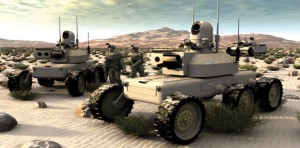May 20
Future Robotic Combat Systems
Robots in warfare are not the stuff of science fiction and Terminator movies anymore. They are not even the stuff of the near future, as the success of the Hellfire missile-armed Predator Unmanned Air Vehicle (UAV) has shown in Afghanistan.

The first generation of combat robots is already with us, which means that from here on out they are only going to become more and more capable. A key program in creating the next generation of military robots is the US Army’s Future Combat Systems (FCS) program, which has several examples of what is expected from these robots.
The US Army is limited by law in the kinds of UAVs they are allowed to work with. True high flying drones like the Predator and its future successors are the province of other services. However, they are doing the best they can within regulations, and an example of this is the Class I UAV. This is a 50 pound hovercraft designed to be carried around in two backpacks.
Once deployed, the robot will travel around the battlefield, lingering where necessary, providing valuable surveillance and target acquisition. It comes with a laser designator, allowing it to both provide coordinates for GPS-guided bombs and to direct laser-guided missiles and bombs to their targets. A step up from the Class I UAV is the Class IV Fire Scout, which is essentially a small UAV helicopter with a payload of 130 pounds. The US Navy is also intending to make use of their own version of the Fire Scout.
On the ground, the Army plans to lighten the load of the solider (or at least use something handier than a truck) by introducing the MULE, a 2.5 ton robot that can serve either as a tough robotic cargo-hauler, or as a combat support vehicle. In the latter role, the MULE is refitted into the ARV, or Armed Robotic Vehicle. This fighting drone combines the usual surveillance and target acquisition functions with a punch, carrying a turret armed with Javelin anti-tank missiles and a 7.62mm machinegun. The MULE’s bigger cousin in the Crusher, a 6.5 ton robotic platform with similar functions.
The smallest of the FCS robots is SUGV, a version of iRobot’s versatile Packbot. This little robot on treads weighs less than 30 pounds regardless of its payload, and thus can be readily toted around by any solider in a regular backpack. This small robot is a natural for urban combat, being small enough to be sent down into ducts, tunnels and sewers, granting it access to routes a human solider could never use. Its 6 pound payload capacity allows it to be fitted with a variety of sensors for surveillance and target acquisition, as well as chemical detection. This is handy robot is the kind of tool that can be deployed right down to even the squad level.

These robots are all examples of the next generation of military robotics. Autonomous and fully independent robotic warriors are still the stuff of science fiction. However, that does not mean the robots under development with FCS are not a major step forward in technology and design purpose. What separates these FCS machines from the first examples of militarized robots is that they are integrated into US Army’s operations down to the lowest level.
This intention often makes a bigger difference to battlefield outcomes than the actual technology. After all, France had more and better tanks in 1940, but it was Germany who put them to the best use. There is nothing improvised about these robots or their role, which was sometimes the case with the previous generation of military robots, and was definitely the case for early armed robots. The US Army of the future will have robots, included armed scouts, doing jobs that will minimize the risk to soldier’s lives at all levels of battlefield operations.
Filed Under: Artificial Intelligence (AI), Featured, Robotics
